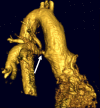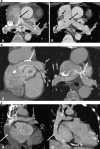Congenital heart diseases: post-operative appearance on multi-detector CT-a pictorial essay
- PMID: 19513718
- PMCID: PMC2778768
- DOI: 10.1007/s00330-009-1474-7
Congenital heart diseases: post-operative appearance on multi-detector CT-a pictorial essay
Abstract
Echocardiography is considered as an initial imaging modality of choice in patients with congenital heart disease (CHD), and magnetic resonance (MR) imaging is preferred for detailed functional information. Multi-detector computed tomography (CT) plays an important role in clinical practice in assessing post-operative morphological and functional information of patients with complex CHD when echocardiography and MR imaging are not contributory. Radiologists should understand and become familiar with the complex morphology and physiology of CHD, as well as with various palliative and corrective surgical procedures performed in these patients, to obtain CT angiograms with diagnostic quality and promptly recognise imaging features of normal post-operative anatomy and complications of these complex surgeries.
Figures












Similar articles
-
Computed tomography imaging of complications in postoperative cyanotic congenital heart diseases - A pictorial essay.Clin Imaging. 2021 Mar;71:1-12. doi: 10.1016/j.clinimag.2020.10.012. Epub 2020 Oct 13. Clin Imaging. 2021. PMID: 33166896 Review.
-
Pre- and postoperative evaluation of congenital heart disease in children and adults with 64-section CT.Radiographics. 2007 May-Jun;27(3):829-46. doi: 10.1148/rg.273065713. Radiographics. 2007. PMID: 17495295 Review.
-
Repaired Congenital Heart Disease in Older Children and Adults: Up-to-Date Practical Assessment and Characteristic Imaging Findings.Radiol Clin North Am. 2020 May;58(3):503-516. doi: 10.1016/j.rcl.2019.12.004. Epub 2020 Feb 26. Radiol Clin North Am. 2020. PMID: 32276700 Review.
-
Role of computed tomography in adult congenital heart disease: A review.J Med Imaging Radiat Sci. 2021 Nov;52(3S):S88-S109. doi: 10.1016/j.jmir.2021.08.008. Epub 2021 Sep 2. J Med Imaging Radiat Sci. 2021. PMID: 34483084 Review.
-
A review of the complementary information available with cardiac magnetic resonance imaging and multi-slice computed tomography (CT) during the study of congenital heart disease.Int J Cardiovasc Imaging. 2004 Dec;20(6):569-78. doi: 10.1007/s10554-004-7021-3. Int J Cardiovasc Imaging. 2004. PMID: 15856644 Review.
Cited by
-
Volumetric Computed Tomography Angiography in the Evaluation of Mediastinal Fluid Collections following Congenital Cardiac Surgery.Case Rep Pediatr. 2013;2013:426923. doi: 10.1155/2013/426923. Epub 2013 Jan 28. Case Rep Pediatr. 2013. PMID: 23424699 Free PMC article.
-
Contrast opacification on thoracic CT angiography: challenges and solutions.Insights Imaging. 2017 Feb;8(1):127-140. doi: 10.1007/s13244-016-0524-3. Epub 2016 Nov 17. Insights Imaging. 2017. PMID: 27858323 Free PMC article. Review.
-
Assessment of intracardiac and extracardiac anomalies associated with coarctation of aorta and interrupted aortic arch using dual-source computed tomography.Sci Rep. 2019 Aug 12;9(1):11656. doi: 10.1038/s41598-019-47136-1. Sci Rep. 2019. PMID: 31406129 Free PMC article.
-
Korean guidelines for the appropriate use of cardiac CT.Korean J Radiol. 2015 Mar-Apr;16(2):251-85. doi: 10.3348/kjr.2015.16.2.251. Epub 2015 Feb 27. Korean J Radiol. 2015. PMID: 25741189 Free PMC article. Review.
-
Pictorial Essay: Understanding of Persistent Left Superior Vena Cava and Its Differential Diagnosis.J Korean Soc Radiol. 2022 Jul;83(4):846-860. doi: 10.3348/jksr.2021.0192. Epub 2022 Jun 22. J Korean Soc Radiol. 2022. PMID: 36238921 Free PMC article.
References
-
- Haramati N, Crooke GA. MR imaging and CT of vascular anomalies and connections in patients with congenital heart disease: significance in surgical planning. Radiographics. 2002;22:337–347. - PubMed
-
- Masui T, Katayama M, Kobayashi S, et al. Gadolinium-enhanced MR angiography in the evaluation of congenital cardiovascular disease pre- and postoperative states in infants and children. J Magn Reson Imaging. 2000;12:1034–1042. doi: 10.1002/1522-2586(200012)12:6<1034::AID-JMRI32>3.0.CO;2-A. - DOI - PubMed
-
- Flohr T, Stierstorfer K, Raupach R, Ulzheimer S, Bruder H. Performance evaluation of a 64-slice CT system with z-flying focal spot. Rofo. 2004;176:1803–1810. - PubMed

